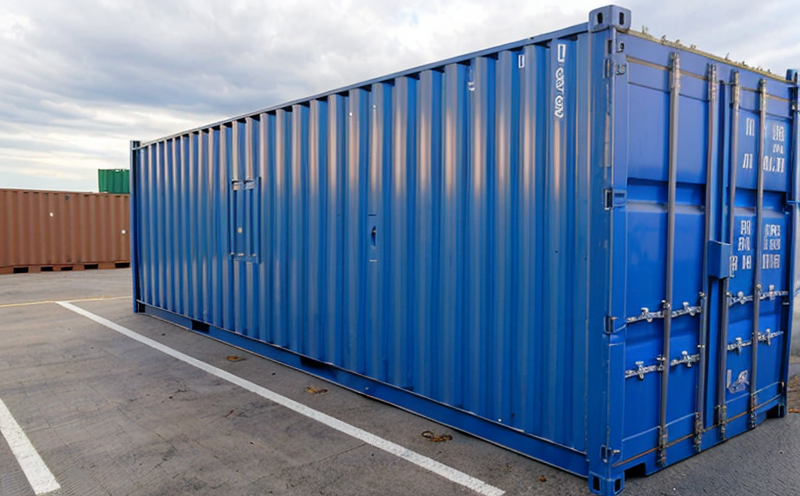BS EN ISO 4582 Weathering Resistance Testing of Plastic Storage Plastics
The BS EN ISO 4582 standard is crucial for assessing the weathering resistance of plastic storage containers. This test evaluates how well the materials used in these containers can withstand exposure to environmental factors such as ultraviolet (UV) light, moisture, and temperature variations over time.
Weathering resistance testing ensures that plastic storage containers maintain their integrity, functionality, and appearance even after long-term exposure to harsh outdoor conditions. This is particularly important for applications where the container must retain its shape, strength, and chemical stability, such as in agricultural, pharmaceutical, or food packaging industries.
The test involves exposing specimens of the plastic storage containers to a combination of UV radiation, humidity cycling, and temperature swings that simulate real-world weathering conditions. The goal is to determine the rate at which physical properties degrade over time under these environmental stresses.
During the testing process, it's essential to consider factors such as the type of plastic used (polyethylene, polypropylene, PVC, etc.), the thickness of the container walls, and any additives or fillers incorporated into the material. These elements significantly influence how well the plastic withstands weathering.
After the exposure period, the specimens are examined for changes in color, mechanical properties like tensile strength and impact resistance, and other physical characteristics that indicate aging damage. Compliance with this standard ensures that products meet stringent quality requirements and can be trusted to perform reliably under various environmental conditions.
The BS EN ISO 4582 test is widely recognized as a robust method for evaluating the weathering performance of plastic storage containers across different sectors, including agriculture, pharmaceuticals, food packaging, and consumer goods. By adhering to this standard, manufacturers can ensure their products are durable, safe, and meet regulatory requirements.
To achieve accurate results, it is crucial to follow the prescribed procedures meticulously. This includes selecting appropriate specimen sizes and shapes that represent the actual product geometry, preparing them correctly before exposure, and conducting thorough inspections post-exposure according to specified criteria.
Applied Standards
| Standard Number | Description |
|---|---|
| BS EN ISO 4582-1:2019 | General requirements and test methods for the weathering resistance of plastics in storage containers. |
| BS EN ISO 4582-2:2019 | Special requirements and test methods for specific types of plastic materials used in storage containers. |
| Environmental Conditions | Description |
|---|---|
| Ultraviolet Radiation | Exposure to UV light sources that simulate outdoor sunlight conditions, typically using xenon arc lamps. |
| Mechanical Stress | Subjecting specimens to cyclic loading tests to mimic real-world handling and usage patterns. |
| Temperature Cycling | Varying the temperature between high and low extremes to simulate changes in ambient conditions over time. |
| Air Humidity | Controlling relative humidity levels within a controlled environment chamber to enhance degradation effects. |
Quality and Reliability Assurance
The BS EN ISO 4582 weathering resistance test plays a pivotal role in maintaining product quality and reliability by ensuring that plastic storage containers remain functional under adverse environmental conditions. This is achieved through rigorous testing protocols designed to replicate real-world exposure scenarios.
Quality assurance teams rely heavily on this standard to verify that materials meet the necessary durability standards before being incorporated into production processes. By adhering strictly to these guidelines, manufacturers can mitigate risks associated with premature failure or degradation of their products, ultimately enhancing customer satisfaction and trust in brand integrity.
In addition to protecting end-users from potential hazards posed by defective containers, compliance with this standard also helps companies comply with international regulations governing product safety and environmental impact. This contributes positively towards sustainable practices within the industry.
Through continuous monitoring and improvement based on test outcomes, organizations can refine their manufacturing methods, optimizing both performance metrics and cost-efficiency factors. Adopting best practices recommended by this standard enables businesses to stay competitive while adhering to global standards for excellence in material science.
Customer Impact and Satisfaction
- Enhanced durability of plastic storage containers ensures longer service life, reducing replacement costs.
- Improved product performance leads to increased customer satisfaction through consistent quality delivery.
- Compliance with international standards boosts brand reputation among consumers who value eco-friendly solutions.
- Increased reliability reduces incidents of accidental breakage or leakage during transportation and storage operations.





